Our view at Stack - Simplify growth with an all-in-one platform. Powerful marketing, sales, and support automation. Integrated CMS. Scalable software. Crafted for customer experience.
Every time I work with a new brand, my first order of business is to conduct a competitive analysis.
A competitive analysis report helps me understand the brand’s position in the market, map competitors’ strengths/weaknesses, and discover growth opportunities.
![Download Now: 10 Competitive Analysis Templates [Free Templates]](https://softwarestack.tech/wp-content/uploads/2024/04/b3ec18aa-f4b2-45e9-851f-6d359263e671.png)
In this article, I’ll break down the exact steps I follow to conduct competitor analysis and identify ways to one-up top brands in the market.
We’ll cover:
- What is competitive analysis?
- What is competitive market research?
- Competitive Analysis in Marketing
- How To Conduct Competitive Analysis in 5 Steps
- How to Do a Competitive Analysis (the Extended Cut)
- Competitive Product Analysis
- Competitive Analysis Example
- Competitive Analysis Templates
- Competitive Analysis FAQs
Competitive analysis gives you a clearer picture of the market landscape to make informed decisions for your growth.
That said, you have to remember that competitive analysis is an opportunity to learn from others. It isn’t:
- Copying successful competitors to the T.
- Trying to undercut others’ pricing.
- A one-and-done exercise.
Let’s look at how this exercise can help your business before breaking down my 5-step competitive analysis framework.
4 Reasons to Perform Competitive Analysis
If you’re on the fence about investing time and effort in analyzing your competitors, know that it gives you a complete picture of the market and where you stand in it.
Here are four main reasons why I perform a competitive analysis exercise whenever working with a brand for the first time:
- Identify your differentiators. Think of competitor analysis as a chance to reflect on your own business and discover what sets you apart from the crowd. And if you’re only starting out, it helps you brainstorm the best opportunities to differentiate your business.
- Find competitors’ strengths. What are your competitors doing right to drive their growth? Analyzing the ins and outs of an industry leader will tell you what they did well to reach the top position in the market.
- Set benchmarks for success. A competitor analysis gives you a realistic idea of mapping your progress with success metrics. While every business has its own path to success, you can always look at a competitor’s trajectory to assess whether you’re on the right track.
- Get closer to your target audience. A good competitor analysis framework zooms in on your audience. It gives you a pulse of your customers by evaluating what they like, dislike, prefer, and complain about when reviewing competing brands.
The bottom line: Whether you’re starting a new business or revamping an existing one, a competitive analysis eliminates guesswork and gives you concrete information to build your business strategy.
What is competitive market research?
Competitive market research is a vital exercise that goes beyond merely comparing products or services. It involves an in-depth analysis of the market metrics that distinguish your offerings from those of your competitors.
A thorough market research doesn’t just highlight these differences but leverages them, laying a solid foundation for a sales and marketing strategy that truly differentiates your business in a bustling market.
In the next section, we’ll explore the nuts and bolts of conducting a detailed competitive analysis tailored to your brand.
Essential Aspects to Cover in Competitive Analysis Research
Before we walk through our step-by-step process for conducting competitor analysis, let’s look at the main aspects to include for every competitor:
- Overview. A summary of the company — where it’s located, target market, and target audience.
- Primary offering. A breakdown of what they sell and how they compare against your brand.
- Pricing strategy. A comparison of their pricing for different products with your pricing.
- Positioning. An analysis of their core messaging to see how they position themselves.
Customer feedback: A curation of what customers have to say about the brand.
Now, it’s time to learn how to conduct a competitive analysis with an example to contextualize each step.
Competitive Analysis in Marketing
Every brand can benefit from regular competitor analysis. By performing a competitor analysis, you’ll be able to:
- Identify gaps in the market.
- Develop new products and services.
- Uncover market trends.
- Market and sell more effectively.
As you can see, learning any of these four components will lead your brand down the path of achievement.
Next, let’s dive into some steps you can take to conduct a comprehensive competitive analysis.
How to Conduct Competitive Analysis in 5 Quick Steps
As a content marketer, I’ve performed a competitive analysis for several brands to improve their messaging, plan their marketing strategy, and explore new channels. Here are the five steps I follow to analyze competitors.
1. Identify and categorize all competitors.
The first step is a simple yet strategic one. You have to identify all possible competitors in your industry, even the lesser-known ones. The goal here is to be aware of all the players in the market instead of arbitrarily choosing to ignore a few.
As you find more and more competitors, categorize them into these buckets:
- Direct competitors. These brands offer the same product/service as you to the same target audience. People will often compare you to these brands when making a buying decision. For example, Arcade and Storylane are direct competitors in the demo automation category.
- Indirect competitors. These businesses solve the same problem but with a different solution. They present opportunities for you to expand your offering. For example, Scribe and Whatfix solve the problem of documentation + internal training, but in different ways.
- Legacy competitors. These are established companies operating in your industry for several years. They have a solid reputation in the market and are a trusted name among customers. For example, Ahrefs is a legacy competitor in the SEO industry.
- Emerging competitors. These are new players in the market with an innovative business model and unique value propositions that pose a threat to existing brands. For example, ChatGPT came in as a disruptor in the conversational AI space and outperformed several brands.
Here’s a competitive matrix classifying brands in the community and housing space:
 Image Source
Image Source
Testing It Out
To help you understand each step clearly, we’ll use the example of Trello and create a competitor analysis report using these steps.
Here’s a table of the main competitors for Trello:
able of the main competitors for Trello:
|
Type of competitors |
Competitor names |
|
Direct competitors |
Asana, Basecamp, Monday.com, MeisterTask |
|
Indirect competitors |
Slack, Notion, Coda |
|
Legacy competitors |
Microsoft Project, Jira |
|
Disruptor competitors |
ClickUp, Airtable |
2. Determine each competitor’s market position.
Once you know all your competitors, start analyzing their position in the market. This step will help you understand where you currently stand in terms of market share and customer satisfaction. It’ll also reveal the big guns in your industry — the leading competitors to prioritize in your analysis report.
Plus, visualizing the market landscape will tell you what’s missing in the current state. You can find gaps and opportunities for your brand to thrive even in a saturated market.
To map competitors’ market positions, create a graph with two factors: market presence (Y-axis) and customer satisfaction (X-axis). Then, place competitors in each of these quadrants:
- Niche. These are brands with a low market share but rank high on customer satisfaction. They’re likely targeting a specific segment of the audience and doing it well.
- Contenders. These brands rank low on customer satisfaction but have a good market presence. They might be new entrants with a strong sales and marketing strategy.
- Leaders. These brands own a big market share and have highly satisfied customers. They’re the dominant players with a solid reputation among your audience.
- High performers. These are another category of new entrants scoring high on customer satisfaction but with a low market share. They’re a good alternative for people not looking to buy from big brands.
This visualization will tell you exactly how crowded the market is. But it’ll also highlight ways to gain momentum and compete with existing brands.
Testing It Out
Here’s a market landscape grid by G2 documenting all of Trello’s competitors in the project management space. For a leading brand like Trello, the goal would be to look at top brands in two quadrants: “Leaders” and “High Performers.”

Image Source
3. Extensively benchmark key competitors.
Step 2 will narrow down your focus from dozens of competitors to the few most important ones to target. Now, it’s time to examine each competitor thoroughly and prepare a benchmarking report.
Remember that this exercise isn’t meant to find shortcomings in every competitor. You have to objectively determine both the good and bad aspects of each brand.
Here are the core factors to consider when benchmarking competitors:
- Quality. Assess the quality of products/services for each competitor. You can compare product features to see what’s giving them an edge over you. You can also evaluate customer reviews to understand what users have to say about the quality of their offering.
- Price. Document the price points for every competitor to understand their pricing tactics. You can also interview their customers to find the value for money from users’ perspectives.
- Customer service. Check how they deliver support — through chat, phone, email, knowledge base, and more. You can also find customer ratings on different third-party platforms.
- Brand reputation. You should also compare each competitor’s reputation in the market to understand how people perceive the brand. Look out for anything critical people say about specific competitors.
- Financial health. If possible, look for performance indicators to assess a brand’s financial progress. You can find data on metrics like revenue growth and profit margins.
This benchmarking exercise will involve a combination of primary and secondary research. Invest enough time in this step to ensure that your competitive analysis is completely airtight.
Check out this example of a competitor benchmarking report for workforce intelligence tools:
 Image Source
Image Source
Testing It Out
Here’s how I benchmarked Asana based on these criteria using the information I could find:
|
Criteria |
Asana |
|
Quality |
|
|
Price |
Offers a free tier and paid plans starting from $10.99/month per user. Advanced features and integrations are available at higher price points. |
|
Customer Service |
|
|
Brand Reputation |
Considered one of the best project management tools, with a slightly more robust feature set compared to competitors. |
4. Deep dive into their marketing strategy.
While the first few steps will tell you what you can improve in your core product or service, you also need to find how competitors market their products.
You need to deep-dive into their marketing strategies to learn how they approach buyers. I analyze every marketing channel, then note my observations on how they speak to their audience and highlight their brand personality.
Here are a few key marketing channels to explore:
- Website. Analyze the website structure and copy to understand their positioning and brand voice.
- Email. Subscribe to emails to learn their cadence, copywriting style, content covered, and other aspects.
- Paid ads. Use tools like Ahrefs and Semrush to find if any competitor is running paid ads on search engines.
- Thought leadership. Follow a brand’s thought leadership efforts with content assets like podcasts, webinars, courses, and more.
- Digital PR. Explore whether a brand is investing in digital PR to build buzz around its business and analyze its strategy.
- Social media. See how actively brands use different social channels and what kind of content is working best for them.
- Partnerships. Analyze high-value partnerships to see if brands work closely with any companies and mutually benefit each other.
You can create a detailed document capturing every detail of a competitor’s marketing strategy. This will give you the right direction to plan your marketing efforts.
5. Perform a SWOT analysis.
The final step in a competitive analysis exercise is creating a SWOT analysis matrix for each company. This means you‘ll take note of your competitor’s strengths, weaknesses, opportunities, and threats. Think of it as the final step to consolidate all your research and answer these questions:
- What is your competitor doing well?
- Where do they have an advantage over your brand?
- What is the weakest area for your competitor?
- Where does your brand have the advantage over your competitor?
- In what areas would you consider this competitor a threat?
- Are there opportunities in the market that your competitor has identified?
You can use tools like Miro to visualize this data. Once you visually present this data, you’ll get a clearer idea of where you can outgrow each competitor.
 Image Source
Image Source
Testing It Out
Here’s a SWOT analysis matrix I created for Asana as a competitor of Trello:
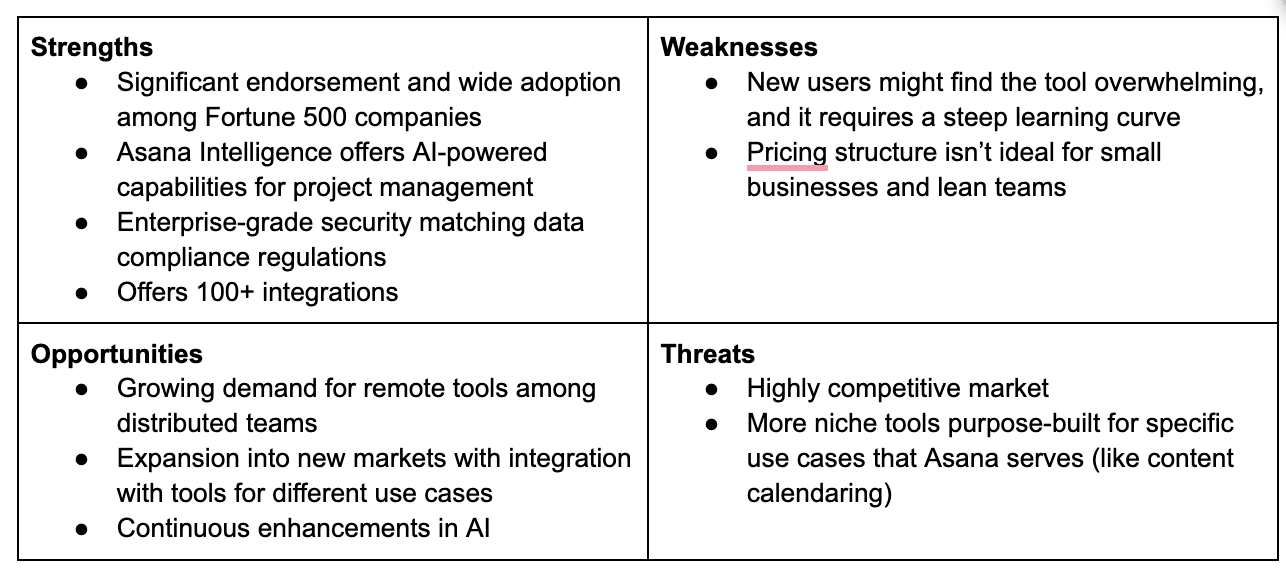
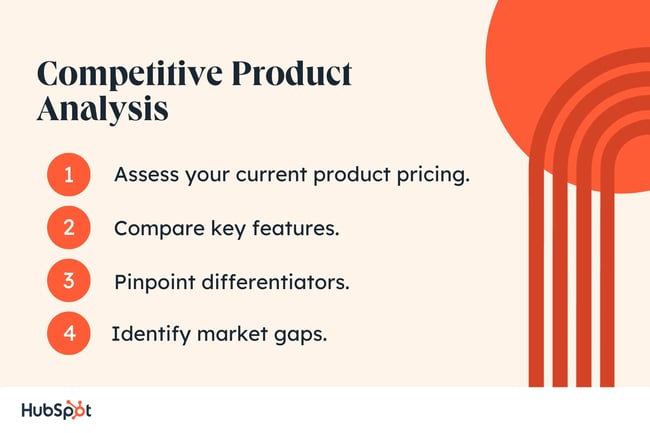
To run a complete and effective competitive analysis, use these ten templates, which range in purpose from sales to marketing to product strategy.
Featured Resource: 10 Competitive Analysis Templates
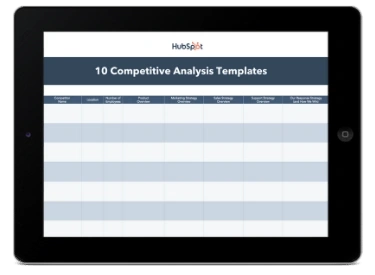
Download Now
1. Determine who your competitors are.
First, you‘ll need to figure out who you’re competing with to compare the data accurately. What works in a business like yours may not work for your brand. Divide your “competitors” into two categories: direct and indirect.
Keep these brands on your radar since they could shift positions at any time and cross over into the direct competitor zone. Using our example, Stitch Fix could start a workout line, which would certainly change things for Fabletics.
This is also one of the reasons why you‘ll want to routinely run a competitor analysis. The market can and will shift at any time, and if you’re not constantly scoping it out, you won‘t be aware of these changes until it’s too late.
2. Determine what products your competitors offer.
You‘ll want to analyze your competitor’s complete product line and the quality of the products or services they’re offering. You should also take note of their pricing and any discounts they’re offering customers.
Some questions to consider include:
- Are they a low-cost or high-cost provider?
- Are they working mainly on volume sales or one-off purchases?
- What is their market share?
- What are the characteristics and needs of their ideal customers?
- Are they using different pricing strategies for online purchases versus brick-and-mortar?
- How does the company differentiate itself from its competitors?
- How do they distribute their products/services?
3. Research your competitors’ sales tactics and results.
Running a sales analysis of your competitors can be a bit tricky.
You’ll want to track down the answers to questions such as:
- What does the sales process look like?
- What channels are they selling through?
- Do they have multiple locations, and how does this give them an advantage?
- Are they expanding? Scaling down?
- Do they have partner reselling programs?
- What are their customers’ reasons for not buying? For ending their relationship with the company?
- What are their revenues each year? What about total sales volume?
- Do they regularly discount their products or services?
- How involved is a salesperson in the process?
These helpful pieces of information will give you an idea of how competitive the sales process is and what information you need to prepare your sales reps with to compete during the final buy stage.
For publicly held companies, you can find annual reports online, but you’ll have to do some sleuthing to find this info from privately owned businesses.
You could find some of this information by searching through your CRM and reaching out to those customers who mentioned they were considering your competitor.
Find out what made them choose your product or service over others out there.
When a competitor is identified, have your sales team dive deeper by asking why they are considering switching to your product. If you’ve already lost the deal, be sure to follow up with the prospect to determine why you lost to your competitor.
4. Take a look at your competitors’ pricing, as well as any perks they offer.
There are a few major factors that go into correctly pricing your product — and one major one is understanding how much your competitors are charging for a similar product or service.
If you feel your product offers superior features compared to those of a competitor, you might consider making your product or service more expensive than industry standards.
However, if you do that, you’ll want to ensure your sales reps are ready to explain why your product is worth the additional cost.
Alternatively, perhaps you feel there‘s a gap in your industry for affordable products. If that’s the case, you might aim to charge less than competitors and appeal to prospects who aren’t looking to break the bank for a high-quality product.
Of course, other factors go into correctly pricing a product, but it‘s critical you stay on top of industry pricing to ensure you’re pricing your product in a way that feels reasonable to prospects.
Additionally, take a look at any perks your competitors offer and how you might match those perks to compete. For instance, perhaps your competitors offer a major referral discount or a month-long free trial version.
These perks could be the reason you‘re losing customers, so if it feels reasonable for your brand, consider where you might match those perks — or provide some unique perks of your own if competitors don’t offer any.
5. Ensure you’re meeting competitive shipping costs.
Did you know expensive shipping is the number one reason for cart abandonment?
Nowadays, free shipping is a major perk that can attract consumers to choose one brand over another. If you work in an industry where shipping is a major factor — like e-commerce — you‘ll want to take a look at competitors’ shipping costs and ensure you’re meeting (if not exceeding) those prices.
If most of your competitors offer free shipping, you‘ll want to look into the option for your own company. If free shipping isn’t a practical option for your business, consider how you might differentiate in other ways — including loyalty programs, holiday discounts, or giveaways on social media.
6. Analyze how your competitors market their products.
Analyzing your competitor’s website is the fastest way to gauge their marketing efforts. This is a great way to see how accessible and engaging their assets are, and if you can, try experimenting with A/B testing your landing pages or website as well. Take note of any of the following items and copy down the specific URL for future reference:
- Do they have a blog?
- Are they creating whitepapers or e-books?
- Do they post videos or webinars?
- Do they have a podcast?
- Are they using static visual content such as infographics and cartoons?
- What about slide decks?
- Do they have a FAQs section?
- Are there featured articles?
- Do you see press releases?
- Do they have a media kit?
- What about case studies?
- Do they publish buying guides and data sheets?
- What online and offline advertising campaigns are they running?
7. Take note of your competition’s content strategy.
Then, take a look at the quantity of these items. Do they have several hundred blog posts or a small handful? Are there five white papers and just one e-book?
Next, determine the frequency of these content assets. Are they publishing something new each week or once a month? How often does a new e-book or case study come out?
Chances are, if you come across a robust archive of content, your competitor has been publishing regularly. Depending on the topics they’re discussing, this content may help you hone in on their lead-generating strategies.
From there, you should move on to evaluating the quality of their content. After all, if the quality is lacking, it won‘t matter how often they post since their target audience won’t find much value in it.
Choose a small handful of samples to review instead of tackling every single piece to make the process more manageable.
Your sampler should include content pieces covering a variety of topics, so you’ll have a fairly complete picture of what your competitor shares with their target audience.
When analyzing your competitor’s content, consider the following questions:
- How accurate is their content?
- Are spelling or grammar errors present?
- How in-depth does their content go? (Is it at the introductory level that just scratches the surface, or does it include more advanced topics with high-level ideas?)
- What tone do they use?
- Is the content structured for readability? (Are they using bullet points, bold headings, and numbered lists?)
- Is their content free and available to anyone, or do their readers need to opt in?
- Who is writing their content? (In-house team? One person? Multiple contributors?)
- Is there a visible byline or bio attached to their articles?
As you continue to scan the content, pay attention to the photos and imagery your competitors are using.
Do you quickly scroll past generic stock photos, or are you impressed by custom illustrations and images? If they’re using stock photos, do they at least have overlays of text quotes or calls-to-action that are specific to their business?
If their photos are custom, are they sourced from outside graphic professionals, or do they appear to be done in-house?
When you have a solid understanding of your competitor‘s content marketing strategy, it’s time to find out if it’s truly working for them.
8. Learn what technology stack your competitors use.
Understanding what types of technology your competitors use can be critical for helping your own company reduce friction and increase momentum within your organization.
For instance, perhaps you‘ve seen positive reviews about a competitor’s customer service — as you’re conducting research, you learn the customer uses powerful customer service software you haven’t been taking advantage of.
This information should arm you with the opportunity to outperform your competitors’ processes.
To figure out which software your competitors use, type the company’s URL into Built With, an effective tool for unveiling what technology your competitors’ site runs on, along with third-party plugins ranging from analytics systems to CRMs.
Alternatively, you might consider looking at competitors’ job listings, particularly for engineer or web developer roles. The job listing will likely mention which tools a candidate needs to be familiar with — a creative way to gain intel into the technology your competitors use.
9. Analyze the level of engagement on your competitor’s content.
To gauge how engaging your competitor‘s content is to their readers, you’ll need to see how their target audience responds to what they’re posting.
Check the average number of comments, shares, and likes on your competitor’s content and find out if:
- Certain topics resonate better than others.
- The comments are negative, positive, or mixed.
- People are tweeting about specific topics more than others.
- Readers respond better to Facebook updates about certain content.
- Don’t forget to note if your competitor categorizes their content using tags and if they have social media follow and share buttons attached to each piece of content.
10. Observe how they promote their marketing content.
From engagement, you‘ll move right along to your competitor’s content promotion strategy.
- Keyword density in the copy itself
- Image ALT text tags
- Use of internal linking
The following questions can also help you prioritize and focus on what to pay attention to:
- Which keywords are your competitors focusing on that you still haven’t tapped into?
- What content of theirs is highly shared and linked to? How does your content compare?
- Which social media platforms are your target audience using?
- What other sites are linking back to your competitor’s site but not yours?
- Who else is sharing what your competitors are publishing?
- Who is referring traffic to your competitor’s site?
- For the keywords you want to focus on, what is the difficulty level? There are several free (and paid) tools that will give you a comprehensive evaluation of your competitor’s search engine optimization.
11. Look at their social media presence, strategies, and go-to platforms.
The last area you‘ll want to evaluate when it comes to marketing is your competitor’s social media presence and engagement rates.
How does your competition drive engagement with their brand through social media? Do you see social sharing buttons with each article? Does your competitor have links to their social media channels in the header, footer, or somewhere else? Are these clearly visible? Do they use calls-to-action with these buttons?
If your competitors are using a social network that you may not be on, it’s worth learning more about how that platform may be able to help your business, too.
To determine if a new social media platform is worth your time, check your competitor’s engagement rates on those sites. First, visit the following sites to see if your competition has an account on these platforms:
- Facebook.
- Twitter.
- Instagram.
- Snapchat.
- LinkedIn.
- YouTube.
- Pinterest.
Then, take note of the following quantitative items from each platform:
- Number of fans/followers.
- Posting frequency and consistency.
- Content engagement. (Are users leaving comments or sharing their posts?)
- Content virality. (How many shares, repins, and retweets do their posts get?)
With the same critical eye you used to gauge your competition’s content marketing strategy, take a fine-toothed comb to analyze their social media strategy.
What kind of content are they posting? Are they more focused on driving people to landing pages, resulting in new leads? Or are they posting visual content to promote engagement and brand awareness?
How much of this content is original? Do they share curated content from other sources? Are these sources regular contributors? What is the overall tone of the content?
How does your competition interact with its followers? How frequently do their followers interact with their content?
After you collect this data, generate an overall grade for the quality of your competitor’s content. This will help you compare the rest of your competitors using a similar grading scale.
12. Perform a SWOT Analysis to learn their strengths, weaknesses, opportunities, and threats.
As you evaluate each component in your competitor analysis (business, sales, and marketing), get into the habit of performing a simplified SWOT analysis at the same time.
This means you‘ll take note of your competitor’s strengths, weaknesses, opportunities, and threats any time you assess an overall grade.
Some questions to get you started include:
- What is your competitor doing well? (Products, content marketing, social
- Where does your competitor have the advantage over your brand?
- What is the weakest area for your competitor?
- Where does your brand have the advantage over your competitor?
- What could they do better with?
- In what areas would you consider this competitor a threat?
- Are there opportunities in the market that your competitor has identified?
You‘ll be able to compare their weaknesses against your strengths and vice versa. By doing this, you can better position your company, and you’ll start to uncover areas for improvement within your own brand.
Competitive Product Analysis
Product analysis drills down to discover key differences and similarities in products that share the same general market.
If you have a competitor selling products in a similar market niche to your own — you want to ensure that you aren’t losing market share to the competition.
Leveraging the example above, we can drill down and discover some of the key differentiators in product offerings.
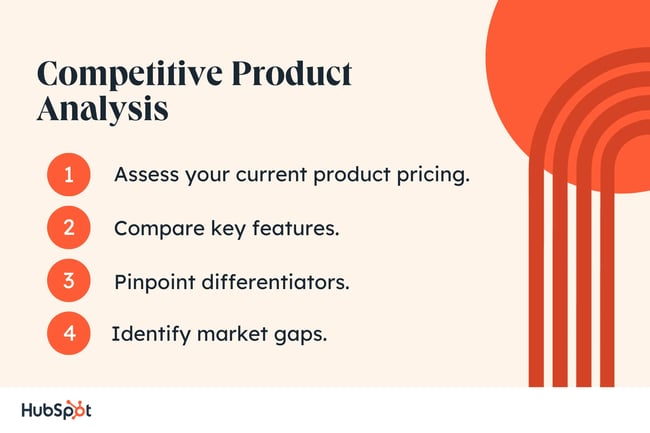
1. Assess your current product pricing.
The first step in any product analysis is to assess current pricing.
Nintendo offers three models of its Switch console: The smaller lite version is priced at $199, the standard version is $299, and the new OLED version is $349.
Sony, meanwhile, offers two versions of its PlayStation 5 console: The standard edition costs $499, and the digital version, which doesn’t include a disc drive, is $399.
2. Compare key features.
Next is a comparison of key features. In the case of our console example, this means comparing features like processing power, memory, and hard drive space.
|
Feature |
PS5 Standard |
Nintendo Switch |
|
Hard drive space |
825 GB |
32 GB |
|
RAM |
16 GB |
4 GB |
|
USB ports |
4 ports |
1 USB 3.0, 2 USB 2.0 |
|
Ethernet connection |
Gigabit |
None |
3. Pinpoint differentiators.
With basic features compared, it’s time to dive deeper with differentiators. While a glance at the chart above seems to indicate that the PS5 is outperforming its competition, this data only tells part of the story.
Here’s why: The big selling point of the standard and OLED Switch models is that they can be played as either handheld consoles or docked with a base station connected to a TV. What’s more, this “switching” happens seamlessly, allowing players to play whenever, wherever.
The Playstation offering, meanwhile, has leaned into market-exclusive games that are only available on its system to help differentiate them from their competitors.
4. Identify market gaps.
The last step in a competitive product analysis is looking for gaps in the market that could help your company get ahead.
When it comes to the console market, one potential opportunity gaining traction is the delivery of games via cloud-based services rather than physical hardware.
Companies like Nvidia and Google have already made inroads in this space, and if they can overcome issues with bandwidth and latency, it could change the market at scale.
Competitive Analysis Example
How do you stack up against the competition? Where are you similar, and what sets you apart? This is the goal of competitive analysis.
By understanding where your brand and competitors overlap and diverge, you’re better positioned to make strategic decisions that can help grow your brand.
Of course, it’s one thing to understand the benefits of competitive analysis, and it’s another to actually carry out an analysis that yields actionable results. Don’t worry — we’ve got you covered with a quick example.
Sony vs. Nintendo: Not all fun and games.
Let’s take a look at popular gaming system companies Sony and Nintendo.
Sony’s newest offering — the Playstation 5 — recently hit the market but has been plagued by supply shortages.
Nintendo’s Switch console, meanwhile, has been around for several years but remains a consistent seller, especially among teens and children.
This scenario is familiar for many companies on both sides of the coin; some have introduced new products designed to compete with established market leaders, while others are looking to ensure that reliable sales don’t fall.
Using some of the steps listed above, here’s a quick competitive analysis example.
1. Determine who your competitors are.
In our example, it’s Sony vs Nintendo, but it’s also worth considering Microsoft’s Xbox, which occupies the same general market vertical.
This is critical for effective analysis; even if you’re focused on specific competitors and how they compare, it’s worth considering other similar market offerings.
2. Determine what products your competitors offer.
PlayStation offers two PS5 versions, digital and standard, at different price points, while Nintendo offers three versions of its console.
Both companies also sell peripherals — for example, Sony sells virtual reality (VR) add-ons, while Nintendo sells gaming peripherals such as steering wheels, tennis rackets, and differing controller configurations.
3. Research your competitors’ sales tactics and results.
When it comes to sales tactics and marketing, Sony and Nintendo have very different approaches.
In part thanks to the recent semiconductor shortage, Sony has driven up demand via scarcity — very low volumes of PS5 consoles remain available. Nintendo, meanwhile, has adopted a broader approach by targeting families as its primary customer base.
This effort is bolstered by the Switch Lite product line, which is smaller and less expensive, making it a popular choice for children.
The numbers tell the tale: Through September 2021, Nintendo sold 14.3 million consoles, while Sony sold 7.8 million.
4. Take a look at your competitors’ pricing, as well as any perks they offer.
Sony has the higher price point: Their standard PS5 sells for $499, while Nintendo’s most expensive offering comes in at $349. Both offer robust digital marketplaces and the ability to easily download new games or services.
Here, the key differentiators are flexibility and fidelity. The Switch is flexible — users can dock it with their television and play it like a standard console or pick it up and take it anywhere as a handheld gaming system.
The PS5, meanwhile, has superior graphics hardware and processing power for gamers who want the highest-fidelity experience.
5. Analyze how your competitors market their products.
If you compare the marketing efforts of Nintendo and Sony, the difference is immediately apparent: Sony’s ads feature realistic in-game footage and speak to the exclusive nature of their game titles.
The company has managed to secure deals with several high-profile game developers for exclusive access to new and existing IPs.
Nintendo, meanwhile, uses brightly lit ads showing happy families playing together or children using their smaller Switches while traveling.
6. Analyze the level of engagement on your competitor’s content.
Engagement helps drive sales and encourage repeat purchases.
While there are several ways to measure engagement, social media is one of the most straightforward: In general, more followers equates to more engagement and greater market impact.
When it comes to our example, Sony enjoys a significant lead over Nintendo: While the official Playstation Facebook page has 38 million followers, Nintendo has just 5 million.
Competitive Analysis Templates
Competitive analysis is complex, especially when you’re assessing multiple companies and products simultaneously.
To help streamline the process, we’ve created 10 free templates that make it possible to see how you stack up against the competition — and what you can do to increase market share.
Let’s break down our SWOT analysis template. Here’s what it looks like:
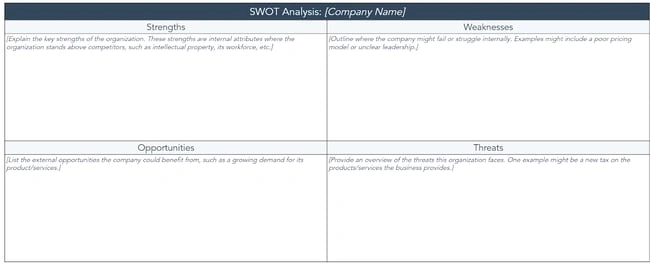
Download Free Templates
Strengths. Identify your strengths. These may include specific pieces of intellectual property, products that are unique to the market, or a workforce that outperforms the competition.
Weaknesses. Here, it’s worth considering potential issues around pricing, leadership, staff turnover, and new competitors in the market.
Opportunities. This part of the SWOT analysis can focus on new market niches, evolving consumer preferences, or new technologies being developed by your company.
Threats. These might include new taxes or regulations on existing products or an increasing number of similar products in the same market space that could negatively affect your overall share.
Competitive Analysis: FAQs
What is a competitive analysis framework?
A competitive analysis framework is a structured approach used to evaluate potential competitors and understand their strengths, weaknesses, opportunities, and threats.
This framework serves as a guide for businesses to identify competitive advantages, understand market positioning, and inform strategic decisions.
Depending on the industry and the company’s objectives, this framework might focus on areas like product features, market share, pricing, customer feedback, and more.
How do you do a good competitive analysis?
Conducting a thorough competitive analysis involves several steps:
- Identify competitors. Start by listing key competitors in your market, both direct and indirect.
- Evaluate their products/services. Analyze what they’re selling and how it compares to your offerings.
- Analyze market position. Determine their market share, brand perception, and unique value proposition.
- Check their marketing strategies. Observe their advertising, content marketing, PR efforts, and online presence.
- Assess their financial health. If available, review financial statements, annual reports, or investor presentations.
- Gather customer feedback. Reviews, testimonials, and surveys can give insights into competitor strengths and weaknesses.
- Regularly review and update. The market evolves, and competitors change strategies, so it’s vital to keep your analysis current.
What are the 5 parts of a competitive analysis?
The five key components of a competitive analysis include:
- Company overview. A brief snapshot of the competitor, including its history, size, and mission.
- Product/service analysis. An examination of their key products or services and how they compare to yours.
- Marketing strategy. Insights into their promotional tactics, target audience, and unique selling propositions.
- Operational analysis. An understanding of their supply chain, distribution, and customer service practices.
- Strengths and weaknesses. A clear breakdown of where the competitor excels and where they might be vulnerable.
What are the 3 C’s in a competitive analysis?
The 3 C’s refer to a strategic model that considers three main factors when understanding the broader business environment:
- Company. Understanding your own strengths, weaknesses, opportunities, and threats.
- Customers. Knowing who your target audience is, what they value, and how they behave.
- Competitors. Analyzing direct and indirect competitors to determine market dynamics and potential threats.
Is SWOT analysis a competitive analysis?
Yes, SWOT analysis is a type of competitive analysis. SWOT stands for Strengths, Weaknesses, Opportunities, and Threats. It is a strategic planning tool used to identify and analyze these four elements of a business.
While a SWOT analysis can be focused internally on a company‘s own attributes, when used as a competitive analysis tool, it assesses a competitor’s SWOT to understand where your business has advantages or might be vulnerable.
How does your business stack up?
Before you accurately compare your competition, you need to establish a baseline. This also helps when it comes time to perform a SWOT analysis.
Take an objective look at your business, sales, and marketing reports through the same metrics you use to evaluate your competition. Record this information just like you would with a competitor and use this as your baseline to compare across the board.
Editor’s Note: This post was originally published prior to July 2018 but has been updated for comprehensiveness.
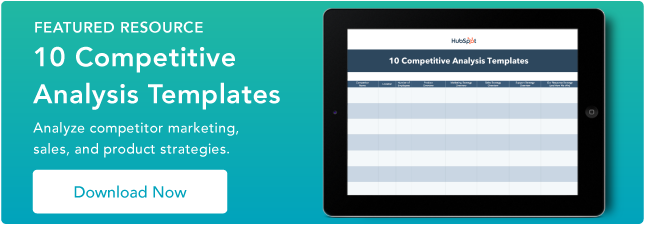
![]()
If Hubspot is of interest and you'd like more information, please do make contact or take a look in more detail here.
Credit: Original article published here.
